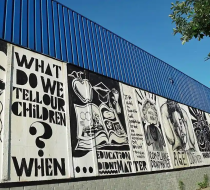Philando Castile: remembering his life through the power of art Favorite
It all started a few months ago, when the Minneapolis Institute of Art got a phone call from Valerie Castile.
Castile is the mother of Philando Castile, the 32-year-old black man who was shot and killed by a police officer in 2016. Valerie Castile has since founded the Philando Castile Relief Foundation, which helps victims of gun violence.
Since her son’s funeral, Castile had amassed hundreds of artworks in her Minneapolis home, from painted portraits of her late son to drawings, sculptures and tapestries. The artworks were gifts from the local community to help the family grieve and heal.
“She wanted to do an exhibition to show her gratitude for all of the artists who have been giving her artwork since her son was fatally shot,” said Nicole Soukup, the assistant contemporary art curator at the Minneapolis Institute of Art. “This exhibition is about a painful, divisive tragedy which shows how the community responded in ways that speaks more to than just what words can do alone.”
The artwork is now on view as part of Art and Healing: In the Moment, which opened last week at the Minneapolis Institute of Art, where 15 artworks by local artists are on view until 29 July. “It encourages our audience to think about this moment in society in a deeper way,” she adds.
When Soukup visited Castile’s home, she was taken back by the amount of artwork she saw. “I was totally surprised by the outpouring of support that the community had been showing her,” she adds. “After discussions with the Castile family, we were able to make an exhibition about art and healing in the moments after this really tragic event.”
Castile’s death was livestreamed on Facebook two summers ago by his fiancé Diamond Reynolds, who said she recorded the video for fear of her own life. It went viral, sparking a resistance movement against racially-charged police brutality, building on the Black Lives Matter movement. The police officer who killed Castile, Jeronimo Yanez, was found not guilty of manslaughter.
When Soukup visited Castile’s home, she spotted over 30 artworks hanging salon-style in her living room, “but I know she has hundreds,” she adds. “The art was stacked up against the walls, cluttering the hallway and in boxes throughout the house.”
There are paintings on canvas, drawings, prints and letters, but that’s not including murals, site-specific art or protest placard artworks made the years after.
The 15 works in the exhibition were selected by Castile, Soukup and the institute’s community advisory panel. “It was clear we needed to create something that wasn’t overwhelming, it was already so moving emotionally,” said Soukup. “We wanted to create pacing, quiet moments alongside these emotional works of art.”
There is a sculpture of a ceramic broken heart by Angie Renee called Why, which includes typewritten-style text on a heart. “She created this heart before Castile’s death, but when she heard the news of Castile, she felt like she had to rip it apart,” said Soukup. “It speaks to a lot of the urgency of how the art was created, it expressed how people dealt with it.”
There’s also a video called I.am.Mural by Xiaolu Wang, which traces the making of a resistance mural about Castile’s death, which was painted on a building that has since been demolished. It was painted by 12 artists in the local community as a response to the police brutality, which read in part: “Straight up HD evidence didn’t matter, the truth is our lives do matter.”
There is also a portrait of Castile in the show by artist Leslie Barlow, who painted him in oil on tissue paper, with his face slightly obscured. “The artist wanted to soften the image, not to hide it in shame but it’s a reliquary of someone who died who is veiled,” said Soukup.
Much of the art is coming from the community who knew Castile personally, or knew of him, as he was a nutritionist working in the cafeteria of the JJ Hill Montessori magnet school. “The incident had a resounding impact of the community,” said Soukup. “The artwork comes from every corner of the city.”
There is also an abstract quilt with geometric patterns in yellow, green and orange, in the exhibition. It was created by textile artist and quilter Aisha Masakella, who inscribed the back with the phrase: “In remembrance of Philando Castile, as a gift to Valerie Castile, may you find comfort in this quilt.”
“She had someone suggest to her in 2016 to make a quilt to honor Castile, and though it took her over a year to make this quilt, she did it,” said Soukup. “It speaks to the artist on what it means being African American today.”
The fatal shooting of Castile has left an undeniable mark on the city and will continue to do so for a long time. “People look at their own community in a new light,” said Soukup. “The artwork speaks volumes, and it’s all dedicated to Valerie Castile, how she is not alone, the artists feel her, see her and hear her in these moments. In that way, it’s quite powerful.”
Art and Healing: In the Moment is on display at the Minneapolis Institute of Art until 29 July







